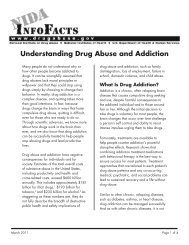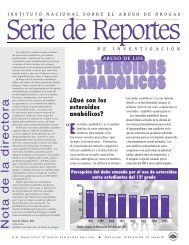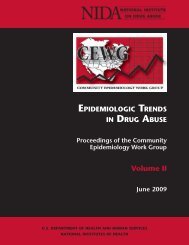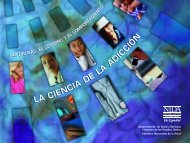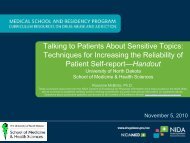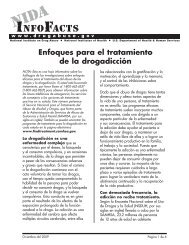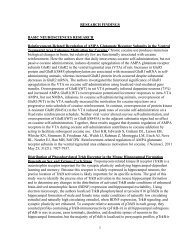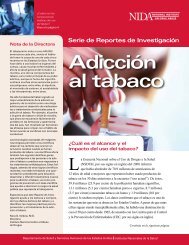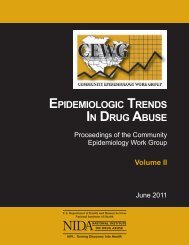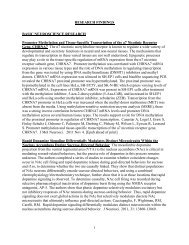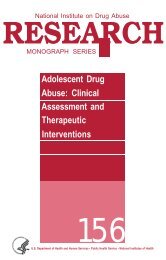CEWG January 09 Full Report - National Institute on Drug Abuse
CEWG January 09 Full Report - National Institute on Drug Abuse
CEWG January 09 Full Report - National Institute on Drug Abuse
Create successful ePaper yourself
Turn your PDF publications into a flip-book with our unique Google optimized e-Paper software.
EpidEmiologic TrEnds in drug AbusE: HigHligHTs And ExEcuTivE summAry<br />
between $700–$3,000 per pound, according to the<br />
NDIC. Am<strong>on</strong>g prescripti<strong>on</strong> drugs, those most<br />
often cited in ethnographic reports as being used<br />
without prescripti<strong>on</strong> were Xanax<br />
® , Vicodin ® ,<br />
Kl<strong>on</strong>opin , cl<strong>on</strong>idine, and methad<strong>on</strong>e. MDMA<br />
was popular<br />
®<br />
in low-income African-American<br />
neighborhoods. Primary users were in their teens<br />
and twenties, but use by middle-aged pers<strong>on</strong>s was<br />
often reported. Prices have declined to $10 per<br />
tablet <strong>on</strong> the South Side and $10–$15 <strong>on</strong> the West<br />
Side. N<strong>on</strong>prescripti<strong>on</strong> buprenorphine (Subox<strong>on</strong>e<br />
) use was increasingly comm<strong>on</strong> am<strong>on</strong>g<br />
heroin<br />
®<br />
users, who mainly used it to avoid withdrawal<br />
or to better manage their addicti<strong>on</strong>. Injecti<strong>on</strong><br />
and recreati<strong>on</strong>al use of Subox<strong>on</strong>e was rare.<br />
<strong>Drug</strong> injecti<strong>on</strong> by young African Americans<br />
®<br />
was<br />
rare. New injecti<strong>on</strong> drug users were likely to be<br />
White and to reside in suburban Chicago. HIV/<br />
AIDS Update: The prevalence and incidence of<br />
human immunodeficiency virus (HIV) infecti<strong>on</strong><br />
am<strong>on</strong>g injecti<strong>on</strong> drug users (IDUs) has declined<br />
markedly, compared with the 1980s and 1990s.<br />
HIV prevalence am<strong>on</strong>g injecting and n<strong>on</strong>injecting<br />
drug users is c<strong>on</strong>verging in low-income Chicago<br />
neighborhoods.<br />
Data Sources: Treatment data for the State<br />
of Illinois and Chicago for FYs 2000–2007 (July 1–<br />
June 30) were provided by the Illinois Divisi<strong>on</strong> of<br />
Alcoholism and Substance <strong>Abuse</strong>. An update was<br />
not available. ED data were derived for the first half<br />
of CY 2008 from the DAWN Live! restricted-access<br />
<strong>on</strong>line query system administered by the Offce<br />
of Applied Studies, Substance <strong>Abuse</strong> and Mental<br />
Health Services Administrati<strong>on</strong> (SAMHSA). The<br />
DAWN Live! data are unweighted and are not<br />
estimates for the reporting area. These data cannot<br />
be compared with DAWN data from 2007 and<br />
before, nor can these preliminary data be used for<br />
comparis<strong>on</strong> with future data. Criminal justice<br />
data were available from the Illinois Criminal Justice<br />
Informati<strong>on</strong> Authority (ICJIA), which collects,<br />
maintains, and updates a variety of criminal justice<br />
data to support its research and evaluati<strong>on</strong> efforts.<br />
ICJIA regularly publishes criminal justice research,<br />
evaluati<strong>on</strong> reports, and statistical profiles. ICJIA’s<br />
drug arrest data for 2005–2006 and the 2004 special<br />
report <strong>on</strong> methamphetamine trends in Illinois were<br />
reviewed. Survey data <strong>on</strong> student and household<br />
populati<strong>on</strong>s were derived from two sources. The<br />
2007 Youth Risk Behavioral Surveillance System,<br />
prepared by the Centers for Disease C<strong>on</strong>trol and<br />
Preventi<strong>on</strong> (CDC), provided drug use data representative<br />
of 9th through 12th grade students in public<br />
and private schools. Data <strong>on</strong> substance use and<br />
abuse for State of Illinois were provided by SAMH<br />
SA’s <str<strong>on</strong>g>Nati<strong>on</strong>al</str<strong>on</strong>g> Survey <strong>on</strong> <strong>Drug</strong> Use and Health for<br />
2005 and 2006. Price and purity data for heroin<br />
for 1991–2007 were provided by the DEA’s HDMP.<br />
The Illinois State Police, Divisi<strong>on</strong> of Forensic Science,<br />
provided purity data <strong>on</strong> drug samples for<br />
2007. <strong>Drug</strong> price data are reported from the June<br />
2007 and December 2007 reports of <str<strong>on</strong>g>Nati<strong>on</strong>al</str<strong>on</strong>g> Illicit<br />
<strong>Drug</strong> Prices by the NDIC. Data from NFLIS for FY<br />
2008 were used to report <strong>on</strong> drugs items identified<br />
in forensic laboratories after being seized by law<br />
enforcement in Chicago. Ethnographic data <strong>on</strong><br />
drug availability, prices, and purity are from observati<strong>on</strong>s<br />
and interviews c<strong>on</strong>ducted by the Community<br />
Outreach Interventi<strong>on</strong> Projects, School of<br />
Public Health, University of Illinois at Chicago.<br />
HIV prevalence data for 2005–2008 were derived<br />
from the <strong>on</strong>going NIDA-funded “Sexual Acquisiti<strong>on</strong><br />
and Transmissi<strong>on</strong> of HIV – Cooperative Agreement<br />
Program” (SATH-CAP) study in Chicago<br />
(U01 DA017378). Resp<strong>on</strong>dent-driven sampling<br />
was used at multiple sites in Chicago to recruit men<br />
and women who use “hard” drugs (cocaine, heroin,<br />
methamphetamine, or any illicit injected drug),<br />
men who have sex with men regardless of drug use,<br />
and sex partners linked to these groups. All participants<br />
(n=3,220) in this <strong>on</strong>going study completed a<br />
computerized self-administered interview and were<br />
tested for HIV, syphilis, chlamydia, and g<strong>on</strong>orrhea.<br />
SATH-CAP data were compared with findings<br />
from earlier studies of IDUs sp<strong>on</strong>sored by NIDA<br />
and the CDC. Several of the sources traditi<strong>on</strong>ally<br />
used for this report have not been updated by their<br />
authors or were unavailable at the time this report<br />
was generated.<br />
40<br />
Proceedings of the Community Epidemiology Work Group, <str<strong>on</strong>g>January</str<strong>on</strong>g> 20<str<strong>on</strong>g>09</str<strong>on</strong>g>



